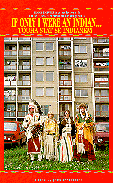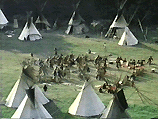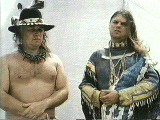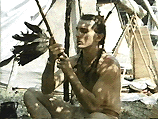


|
If Only I Were an Indian
Directed by John Paskievich. Subject Headings:
Grades 7 and up / Ages 12 and up.
|
excerpt:
"The prophecy stated that our people would suffer under this domination of the white people. And at that time the world would have been in such a state that a lot of things were destroyed, that white people would come to the Indian and learn about the ways of our people. . .
 A group of Czechs and Slovaks, disenchanted with both communism and its
aftermath, gathers in a field to build and live in teepees, create and
smoke peace pipes -- to get in touch with the North American aboriginal
way of life and live it. When three aboriginal elders from Manitoba go to
visit them, a film crew documents the trip and thus If Only I Were
an Indian is born.
A group of Czechs and Slovaks, disenchanted with both communism and its
aftermath, gathers in a field to build and live in teepees, create and
smoke peace pipes -- to get in touch with the North American aboriginal
way of life and live it. When three aboriginal elders from Manitoba go to
visit them, a film crew documents the trip and thus If Only I Were
an Indian is born.

As a child, I didn't want to be an astronaut . . . but neither did I want to be a world record breaking potato sorter . . . we had no role models except from the Indians of those stories.

Highly recommended.
Charmagne de Veer is a freelance writer and editor who currently writes for Herizons magazine.
An interview with filmmaker John Paskievich appears in this issue of CM

Copyright © 1995 the Manitoba Library Association.
Reproduction for personal use is permitted only if this copyright notice is
maintained. Any other reproduction is prohibited without permission.
Published by
The Manitoba Library Association
ISSN 1201-9364
 Go back to CM Welcome page
Go back to CM Welcome page
 Go back to Table of
Contents for this Issue
Go back to Table of
Contents for this Issue